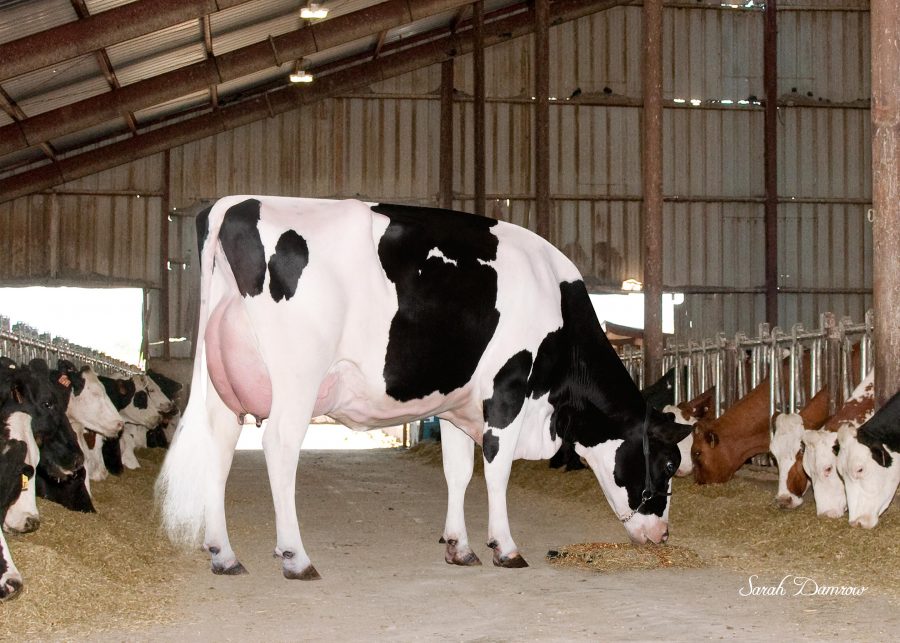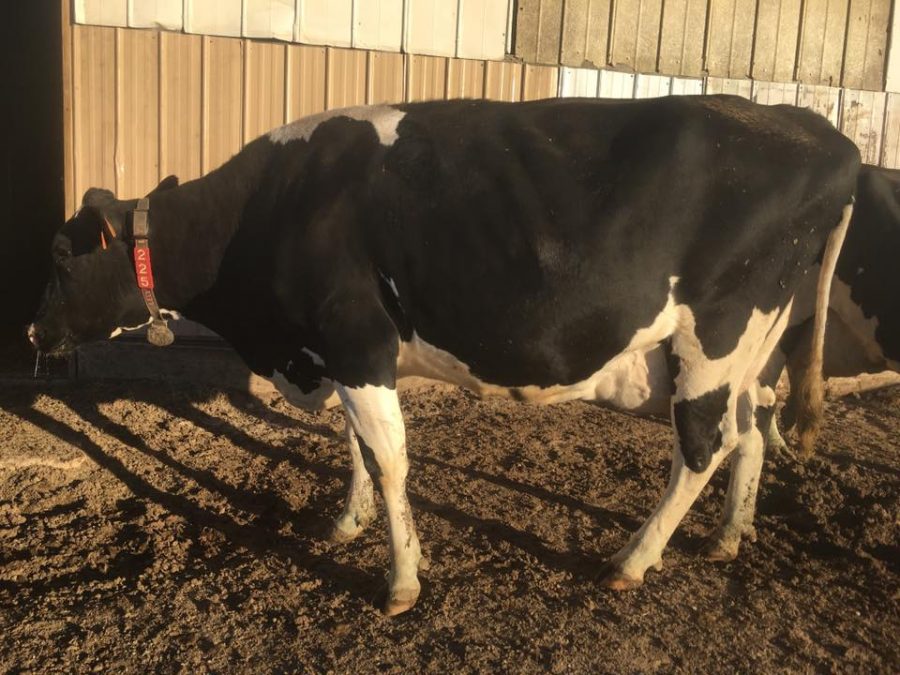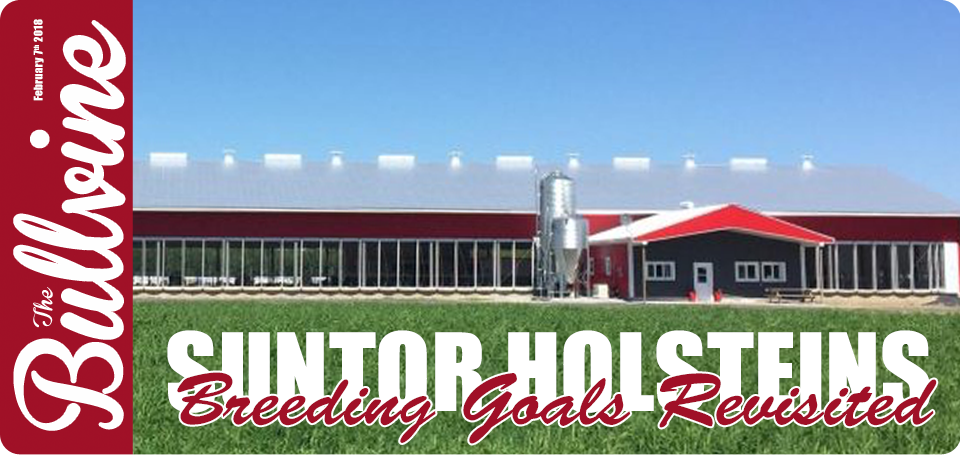Many factors can lead herd owners to change their breeding goals. They may have bred to participate in shows but haven’t got their animals placed near or at the top of the class. Perhaps their herd is not producing enough milk or milk solids. Others may find that their herd needs to be genetically better for health and fertility reasons. It could be that the next generation of owners has decided to go a different route in dairy farming. Whatever the reason the implementation of a new selection scheme, with the same breed or by using cross breeding, takes a plan with defined goals in mind.
Suntor Holsteins, Ormstown Quebec, has reached the point where changes are being made in their breeding program. Recently, The Bullvine produced an article on the planning and building of new housing and robotic stall milking at Suntor (Suntor Holsteins – New Baby, New Robot, New Perspective). This article will cover the thoughts of Kevin Sundborg as he decides on the direction of Suntor’s future breeding program.
Suntor’s Past Breeding Program
As described in the previous article, Suntor has been housed in a typical Canadian tie stall barn and has won two Master Breeders Shields. That was after Fred and Ruth Sundborg had started with a grade Holstein herd in 1973 and were fully purebred by 1981. If a proven bull did not leave high type daughters, he did not get used in the Suntor herd and only young sires from high type families were sampled in the herd. Kevin, who is Fred (herd founder) and Ruth’s son and the current co-owner with wife Amanda, told the Bullvine that back in those days, “the goal was to get VG 2year-olds producing 80 lbs at their peak because that is what got the attention of cattle buyers and other breeders”.
Now move forward to the 1990s when TPI and LPI were created. Initially both these total merit indexes placed approximately 50:50 emphasis on type and production. Suntor adopted the use of LPI when selecting sires both proven (70%) and unproven (30%). With time LPI placed 40:60 emphasis on type and production. When health and fertility traits were added to the LPI, Suntor again followed the breed recommended LPI and considered production, type and health/fertility when selecting sires.
Why Breeding Needs Have Changed
It’s now 2017 and Suntor has two robots milking their herd and Kevin and Amanda have plans for 80 cows producing 140 kgs of fat per day. It does not matter that a first calf heifer is not 60” tall or that she needs to be stylish, but it does matter how much high-quality milk she produces. It also matters that she is fertile and goes about her work without creating issues that require Suntor owners’ attention.
These factors have resulted in Suntor commencing to use sires with a different mix of attributes than the sires that they had used in the past.
New Ideal Young Cow
Kevin described to The Bullvine two first calf heifers currently in their herd. One is 61” tall and the classifier scored her VG86 with a shallow VG87 udder. She is producing 37 kgs (81 lbs) of 3.7%F 3.0%P milk after calving at 25 months. The other heifer is 57” tall, classified GP80, has a GP80 udder, has excellent mobility, and will produce 13,000 kgs of 4.0%F, 3.3%P milk in 305 days after calving at 22 months. In Kevin’s words – “In the past we would have preferred the first heifer, but now we also appreciate the second heifer as well. Today Kevin and Amanda are finding that the robots had no trouble in milking the second heifer and her moderate frame size means a lower body maintenance requirement for feed. Her excellent mobility greatly improves her chances of a long trouble-free life in their free stall-robot operation. (Read More – She ain’t pretty she just milks that way)
Based on what Kevin is seeing in the cows that do the best job in their new set-up, he has modified his sire selection criteria. He says he still wants balanced cows and has added good milking speed, positive indexes for wellness traits and high component production to his must haves in the sires he uses.
Other Breeders Have an Ideal for Young Cows
But Kevin is not the only breeder to be breeding for a different type of young cow than they did in the past.
Alan Andersen of the well-known SeaGull Bay Dairy in Idaho considers their ideal first calver to be 54-56” tall, classifying GP80-82 with an udder capable of producing 110+ lbs of milk (3x) per day. They want cows that will breed back on 1st or 2nd service and have zero health or metabolic problems. The Andersen Family milks 2,400 cows, 25% Holsteins and 75% crossbreds (Holstein x Montbeliarde x Viking Red). Their Holsteins must keep up with the crossbred for fertility, health and longevity. The picture below is one of their first calvers, 6-7 months fresh, that classified GP81 (2yr). She represents that kind of Holstein young cow that SeaGull Bay wants to breed and work with. In her first lactation she stood 56” tall and produced on 305 days (3x) 29,350 # milk, 4.3%F 1264#F and 3.3%P 966#P. That’s 2230 # (1010 kgs) of fat + protein. She peaked at 121# milk per day. On a relative basis she was 130% compared to her contemporaries for yield.

Aardema Cabriolet 7820
Mark Yeazel, Ja-Bob Holsteins in Ohio, gives serious consideration to his operation’s needs when selecting sires for his 120 cow free stall robot milked herd. Mark wants the productive trouble-free kind of cow. Wide chested, moderate stature, functional udders (good milking speed, no reverse tilt, wide at rear to allow for easy robotic teat cup attachment, teats of moderate length and well-spaced and good udder texture), excellent mobility and wide and properly located thurls. Mark says, ‘If their rear teats cross or they are slow milking, I must sell them as I run my robots to capacity and I cannot tolerate cows that cannot be milked properly or take too long in the robot”. Mark considers all genetic indexes and aAa when mating his cows. In his opinion “high TPI sires often only get to be high because they sire daughters that have short teats, are overly tall, likely lack udder depth and capacity and will lack adequate body width”.

Jotan (Red) x Burket Falls Poll Pledge PP x Lawnboy average cell 101 2-09 305 28829 4.8% 1379 3.6% 1051 365d 31640 4.8% 1525 3.7 %1174 true protein 3 -9 now Bred first service on first lactation, took a couple extra this time. she is GP 81. Her dam was 2nd high cow for protein in state as 4 year old.
The Truth Is
Every day more and more breeders are fitting their breeding goals to their plans and operation rather than just following what was used in the past or that their neighbor use.
Try These Breeding Thoughts on For Size
During our discussions with Kevin Sundborg, he mentioned to us some thoughts that are guiding him as he changes his breeding program. We share Kevin’s points with Bullvine readers, so that they can consider refining or changing their sire selection criteria to more nearly fit the cattle needed in their own operations.
Kevin’s thoughts:
- “Milk production (milk and milk solids) will be generating our revenue in the future.”
- “Heifers that calve at 21-22 months and are 55-57” do a lot of growing and easily make 59-61” cows. That’s tall enough.”
- “Shorter and medium stature cows tend to have fewer problems in free stalls than do taller cows.”
- “We feel that +5 to +9 CONF or +1.0 to +2.0 PTAT sires with high production and good health & fertility are the ones we need to use.”
- “We have been and will continue to use Pp and PP (polled) sires.”
- “We will be using the genetic indexes for health traits when selecting sires in the future.”
- “We are interested in the sire genetic indexes soon to be available for feed conversion.”
- “It comes down to how much dry matter a cow can take in rather than how tall or how wide she is.”
- “In our robotic operation we will likely continue to use type classification and DHI programs.
The Bullvine Bottom Line
Do you agree with Kevin’s thoughts? Or do you lean toward the way SeaGull Bay or Ja-Bob are breeding for the future? Do you have additional thoughts?
Eventually, from your semen buying pattern, your semen suppliers will know your future genetic requirements. However, in the mean-time, you can help them by sharing your thoughts with the representatives who service your farm.
Breeding dairy cows is dynamic. It won’t be the same tomorrow as it was yesterday or ten years ago. Not every type of cow is the best for every system or environment.
The important thing is that each breeder decides what’s best genetically for their operation and then selects sires that produce daughters that conform to their future herd’s needs.

















